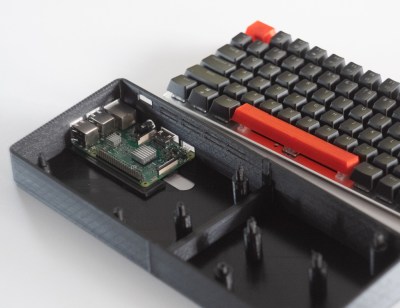If you hang around Hackaday long enough, pretty soon you’ll start to see some patterns emerging. As the nexus of all things awesome in the hacking world, our front page offers a unique vantage point by which you can see what’s getting folks excited this particular month, year, or decade. Right now we can tell you hackers love the Raspberry Pi, 3D printing, and perhaps above all, they can’t get enough mechanical keyboards.
 So that makes the Jazzberry by [Mattis Folkestad] something of a perfect storm in the hacker world. The project uses a 3D printed enclosure to combine a Raspberry Pi 3B+ and an Ajazz AK33 mechanical keyboard into a single unit like the home computers of old. Honestly, we’re just glad he didn’t sneak an ESP8266 in there; as the resulting combination might have been enough to crash the site.
So that makes the Jazzberry by [Mattis Folkestad] something of a perfect storm in the hacker world. The project uses a 3D printed enclosure to combine a Raspberry Pi 3B+ and an Ajazz AK33 mechanical keyboard into a single unit like the home computers of old. Honestly, we’re just glad he didn’t sneak an ESP8266 in there; as the resulting combination might have been enough to crash the site.
That being said, we can’t help but notice there’s a lot of open space inside the 3D printed enclosure. Right now there’s nothing inside but the Raspberry Pi, which only takes up a fraction of the internal volume. Adding a battery and hard drive would be the logical next steps, but it could also be outfitted with a suite of radios and various other hacking and security research accoutrements. We’ve seen an influx of such builds over the last few months, and the Jazzberry seems like it could make a very slick entry into this burgeoning category of mobile pentesting devices.
The STL files are designed specifically for the combination of hardware that [Mattis] used, but it shouldn’t be too difficult to modify them for your own purposes. Even if you stick with the same AK33 keyboard, an upgrade to the impressively powerful Raspberry Pi 4 would be more than worth the time fiddling with the STLs in your CAD tool of choice. If you really want to go all in, add a display and you’re well on the way to that cyberdeck you’ve always wanted.
















RIP your wrists
yeah, first thing I thought too
B-but raspberry pi!
B-but carpal tunnel syndrome!
Not any worse than my C-64 that I used for almost the entire 80’s and was then replaced by my Laser Compact XT.
I was considering replicating the XT with a pi since I have two boards.
We were younger then. Our hands could take the abuse. :-)
Wrist rests are of the devil, it’s easier to type if you hold them in the air and let your hands float around over the keyboard.
Yeah, I like it, but this could also be done with a lower-profile board to save the wrists. :-)
I wish they sold the Pi 2-3-4 without the USB/Ethernet/40-pin plugs populated for stuff like this, or made a better Zero.
Lower profile keycaps and / or switches are needed. Trouble is, the most common low profile switches use a scissor mechanism AND a different keycap mount, frustrating the mechanical switch enthusiasts.
There’s the Cherry line of low profile mechanical switches (ML series) but subjectively they’re pretty awful.
I think they have to keep the format of “zero” model, with Al connectors on a side. This way, it can be plugged in a power slot in a monitor, in everything.
change to zx88 design, amll linear screen up to keyboard, and put rp zero for small high
LOL: AK33 Keyboard with Raspberry Pi inside a A600 3d Printed Case: https://www.facebook.com/Amiga-Evolution-696056977515499/
Maybe if you didn’t document the thing on Facebook, you’d get a little more attention…
I’m staying away from the Pi 4 until they revise it by *correctly* connecting up the USB C port like is in the specifications.
If you are going to wait, then wait until the entire video sectiongets moved to an adapter board. You can already daisy chain monitors with Display Ports, sothe dual HDMI connectors are already questionable.
AR glasses, with one screen per eye, would combine nicely with something housed in a keyboard. A bitlike a laptop with no screen – just a protective perspex cover.
So basically they invented a Commodore 64 XD
Wasn’t a bad form factor though… But this one is a bit too thick for ergonomics IMO.